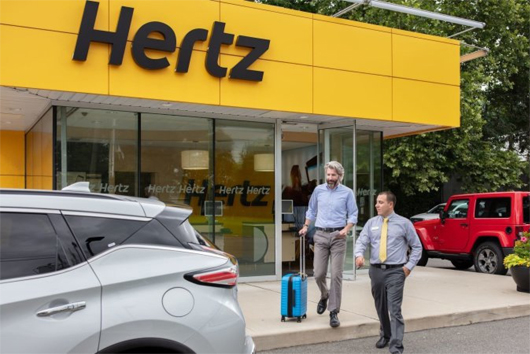Hertz Shifts Gears: Selling Teslas, Embracing Hybrids in a Calculated Gamble
Hertz, the iconic car rental company known for its yellow cars and convenient locations, is taking a sharp turn on the road to the future. In a surprising move, the company announced it will be selling nearly a third of its electric vehicles (EVs), primarily Teslas, and refocusing its fleet on hybrid cars. This seemingly drastic decision, however, reflects a calculated strategy by Hertz to adapt to the changing dynamics of the car rental market and ensure its long-term financial health.
EV Sell-Off: Balancing the Books
The decision to sell off a significant portion of its EV fleet, estimated to be around 20,000 Teslas, stems from the harsh reality of depreciation. EVs, despite their environmental benefits, tend to lose value faster than traditional gasoline-powered cars. This rapid depreciation puts a strain on Hertz’s bottom line, making it financially unsustainable to maintain such a large EV fleet.
Hybrids: Finding the Sweet Spot
Instead of going all-in on EVs, Hertz is opting for a more balanced approach by investing in hybrid cars. Hybrids offer the best of both worlds: the fuel efficiency of electric motors combined with the range and affordability of gasoline engines. This strategic shift caters to a broader customer base, including those who may not be ready for a full commitment to EVs due to concerns about charging infrastructure or upfront costs.
Financial Maneuvers: Short-Term Gains, Long-Term Vision
The proceeds from the EV sale will be used to purchase internal combustion engine (ICE) cars, providing Hertz with much-needed financial flexibility in the short term. This move also allows the company to improve its fleet profitability by choosing cars with lower depreciation costs. However, it’s important to note that Hertz hasn’t completely abandoned EVs. The company still plans to maintain a smaller fleet of electric cars to cater to environmentally conscious customers and comply with evolving regulations.
Market Adaptation: A Sign of Things to Come?
Hertz’s decision to sell EVs and invest in hybrids is not an isolated incident. It reflects the broader challenges faced by the EV market, including high upfront costs, limited charging infrastructure, and concerns about battery life and resale value. As a result, other car rental companies might follow suit, prioritizing financial sustainability and operational efficiency over aggressive EV adoption.
Navigating the Evolving Landscape
Hertz’s shift in strategy highlights the need for businesses to be adaptable in the face of rapid change. The car rental industry, like many others, is facing significant disruption due to emerging technologies and changing consumer preferences. By acknowledging the limitations of the current EV market and making strategic adjustments, Hertz is taking a calculated gamble to ensure its long-term survival and success.
The Road Ahead: A Bumpy Ride with Unending Possibilities
The future of the car rental industry, and the role of EVs within it, remains uncertain. Hertz’s decision, however, marks a significant turning point. It opens the door for a more balanced approach to EV adoption, prioritizing financial sustainability while still catering to environmentally conscious customers. As the technology improves and infrastructure expands, EVs are bound to play a larger role in the future of car rentals. But for now, Hertz’s strategic shift reminds us that even the most iconic companies need to adapt and adjust to navigate the ever-changing road ahead.
The future of car rentals, and the role of EVs within it, is an exciting and uncertain landscape. One thing is for sure, though: the ride promises to be bumpy, but filled with endless possibilities.






Xcipha
buy ivermectin 6mg online – purchase stromectol online buy carbamazepine 200mg online
January 2, 2025Ysrwqm
accutane 10mg tablet – linezolid price order generic zyvox 600 mg
January 17, 2025Jrkrxs
purchase amoxil without prescription – order generic amoxil cost ipratropium
January 18, 2025Lxgset
zithromax cost – buy bystolic 5mg generic purchase bystolic generic
January 31, 2025Goewjm
order generic prednisolone – how to buy prometrium order prometrium 200mg
February 2, 2025Kcesrc
buy gabapentin 600mg online cheap – order neurontin 800mg online order sporanox 100mg
February 9, 2025Vsdarg
order lasix without prescription – lasix uk buy generic betnovate for sale
February 9, 2025Iupnrv
augmentin 625mg brand – augmentin without prescription duloxetine 40mg pill
February 15, 2025Qzuqlx
acticlate us – albuterol generic buy glipizide 10mg online
February 16, 2025Exrgxb
order rybelsus 14 mg generic – order cyproheptadine 4mg pill periactin 4mg for sale
February 25, 2025Bjnkxa
buy cheap tizanidine – buy zanaflex online cheap buy microzide 25 mg online
February 28, 2025Nvyzfe
cialis from canada – canadian viagra and healthcare sildenafil over the counter
March 6, 2025Dauocc
viagra for men over 50 – cialis canada tadalafil 10mg ca
March 7, 2025Lbwwpw
brand lipitor 10mg – lisinopril 10mg pills order lisinopril 10mg pills
March 14, 2025Fqfnss
buy cenforce 100mg generic – buy metformin 500mg online cheap glycomet 1000mg drug
March 16, 2025Ofavbk
buy generic prilosec – oral prilosec order tenormin 100mg online
March 21, 2025Ntdmjm
medrol 8 mg pills – order aristocort 10mg without prescription buy triamcinolone pills
March 27, 2025Chztmt
order desloratadine – clarinex pills priligy 30mg generic
March 29, 2025Holaaj
purchase cytotec – buy generic cytotec 200mcg diltiazem 180mg uk
March 31, 2025Abfpus
zovirax order online – order rosuvastatin 20mg sale rosuvastatin 20mg over the counter
April 5, 2025Wjeqri
buy domperidone generic – sumycin ca buy cyclobenzaprine 15mg
April 8, 2025Jtqwah
buy generic domperidone for sale – flexeril 15mg canada order cyclobenzaprine 15mg online cheap
April 15, 2025Feejqo
where can i buy inderal – order methotrexate 5mg pill order methotrexate 5mg online cheap
April 17, 2025Nmtved
coumadin canada – buy warfarin pills order cozaar pill
April 20, 2025Orznbc
purchase levofloxacin sale – purchase avodart generic order zantac 150mg generic
April 24, 2025Xwphoj
nexium where to buy – generic topiramate purchase imitrex generic
April 24, 2025Epoybk
mobic medication – buy meloxicam 15mg for sale buy tamsulosin pills for sale
April 30, 2025Eejxir
ondansetron 8mg ca – simvastatin sale oral zocor
May 17, 2025Zhnbbo
valacyclovir 1000mg price – purchase finasteride pill order diflucan pills
May 18, 2025297m4
order modafinil 100mg sale buy provigil for sale buy provigil pills for sale provigil order online generic modafinil 100mg generic provigil 200mg buy modafinil 100mg generic
June 1, 20253720h
can i get cheap clomid without prescription can you buy clomiphene prices how to buy generic clomid tablets generic clomiphene c10m1d get generic clomiphene prices cost of generic clomid without rx buying cheap clomid without prescription
June 3, 2025very nice site cheap cialis
More posts like this would add up to the online play more useful.
June 9, 2025generic cialis tadalafil best buys
Thanks for sharing. It’s outstrip quality.
June 9, 2025can i take bactrim and flagyl at the same time
I’ll certainly bring to review more.
June 11, 2025buy generic flagyl online
Proof blog you have here.. It’s severely to on great quality writing like yours these days. I justifiably comprehend individuals like you! Withstand care!!
June 11, 2025kdu5r
zithromax for sale online – sumycin drug buy metronidazole 200mg for sale
June 12, 2025pnt3c
order zithromax 500mg – cheap metronidazole 400mg buy metronidazole 200mg online cheap
June 13, 2025